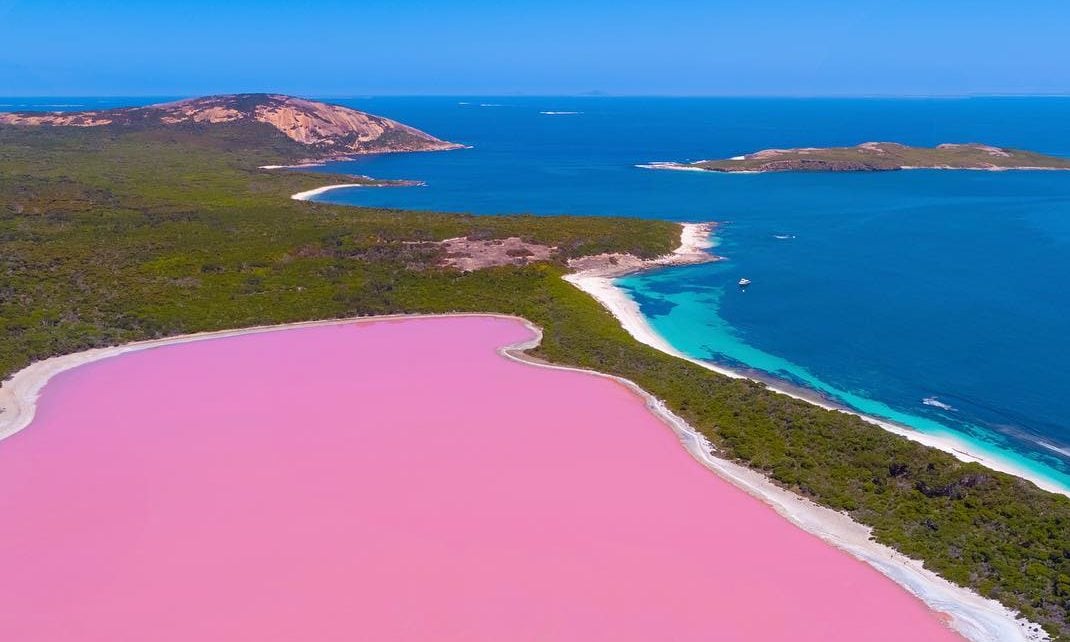When you planned your Aussie adventure, you probably didn’t put its lakes at the top of your must-see list. Sure, Australia has hundreds of beautiful places to visit – the Blue Mountains, Fraser Island and Bondi Beach might very well be on your list – but don’t overlook some of the most spectacular bodies of water the southern hemisphere has to offer.
From the incredible pink lakes of Western Australia to the true-to-its-name Blue Lake down in SA, get ready to take your most Insta-worthy snaps yet. Pick up your backpack and journey on to discover exactly why Australia’s lakes are well worth writing a postcard about.
Blue Lake – Mount Gambier, South Australia
If you’re in SA between December and March, the Blue Lake in Mount Gambier is a must. An exceptional sight, the lake is formed in a volcanic crater, annually turning a striking shade of cobalt during these four aforementioned months (the theory is that its water temperature triggers this remarkable colour transition).
Take a 3.6km walking trail to view Blue Lake from its best angles. Fly solo or join one of the lake’s regular tours to discover more. Mount Gambier’s town centre is only a couple of kilometres from the lake, making amenities within easy reach, while there is a cafe at the lake edge itself. There are regular flights to Mount Gambier from Melbourne, making this a simple way to travel to the Blue Lake if you don’t have a vehicle.
Lake McKenzie – Fraser Island, Queensland
You’ve probably already got Fraser Island on your itinerary, not least for its unmatched beauty and tranquillity. Lake McKenzie, nestled at the heart of this stunning island, is formed wholly by rainwater, while its white sand basin ensures purity and clarity, making it a vision of crystal aquamarine. It’s perfect for swimming in and an oasis of relaxation.
While Lake McKenzie has camping facilities, including toilets and cold showers, stock up on food and drink in Eurong (11km away) before heading to this lake. Fraser Island is accessible via the M1/A1 highways and is situated roughly 400km north of Brisbane.
Lake St Clair – Tasmania
Made it to Tas? Then head over to Lake St Clair, just five kilometres from the village of Derwent Bridge, the gateway to the Cradle Mountain – Lake St Clair National Park. This lake is famed for its depth of 547 feet (167 metres), making it Australia’s deepest. The scenery surrounding the lake is a sight to behold, with dense forest and rocky panoramas truly awe-inspiring. Lake St Clair’s extensive facilities, including a shop, a restaurant, toilets and even an interactive centre, give you even fewer excuses not to visit.
Dove Lake – Tasmania
While you’re in Tasmania, make the most of it and travel to Dove Lake, 70km north of Lake St Clair at the northern end of the Cradle Mountain – Lake St Clair National Park. With several walking paths to the nearby Cradle Mountain, Dove Lake is known for its exceptional beauty, making it a popular tourist attraction. You can visit this lake with ease thanks to the shuttle bus, the price of which is included in your entry fee to the National Park.
Lake Eyre – South Australia
We’ve covered the deepest – now it’s time for the biggest. After rainfall, Lake Eyre covers almost 3,700 square miles. It also holds the title of Australia’s lowest mainland at 15m below sea level. Expect to encounter less water than a traditional lake, with the typically dry Lake Eyre appearing more like a salt pan than a lake. Nonetheless, it is spectacular, if not extremely remote, with the tiny township of Marree being one of the closest points of civilisation, 134km away. This is one lake best viewed from above by taking a flight from William Creek, 200km north-west of Marree. Ensure you’re well-equipped and prepared before heading out here.
Lake Hillier – Middle Island, Western Australia
Want to see something a little different? Check out Lake Hillier on the gorgeous southern Middle Island. There’s one key feature that makes this lake stand out: it’s pink! Its unusual shade is caused by its resident microorganisms, Dunaliella salina, reacting with the lake’s salt. As the island is so remote, the only viable way of seeing Lake Hillier first hand is to take a helicopter flight from Esperance, at roughly a two-hour return flight. Travel to Esperance via State Route 40/National Route 1, a drive taking just over seven hours.
Lake Ballard – Western Australia
Lake Ballard proclaims itself as the “largest outdoor gallery” of Australia, so if you’re into art, it’s a definite for your Australian scenery bucket list. Renowned British artist Antony Gormley installed 51 metal figures at the lake back in 2002, and their haunting presence is still a remarkable sight to this day. It’s a 51km drive on unsealed roads from Menzies, where you can find typical amenities to take with you; otherwise, toilets are available, but little else other than a true masterpiece of an installation!
Lake Albina – New South Wales
Perhaps a little unexpected for a country known for its vast arid outback, Lake Albina in NSW is a glacial lake. Its scenery is more akin to Scotland than Australia, which is why this lake is such a delight and worth putting your walking boots on for. It’s just 2.5km from the highest mountain in Australia – Mount Kosciuszko, 2,228m above sea level – and is only accessed via the incredible 22km Main Range walk. Start this in Charlotte’s Pass, a locality just under three hours’ drive from Canberra. Be sure to bring all your usual hiking essentials with you, as there’s no chance of finding a cafe or even a toilet at these heights!
If you think we’ve missed a great Aussie lake worth visiting, please add it in the comments below.

